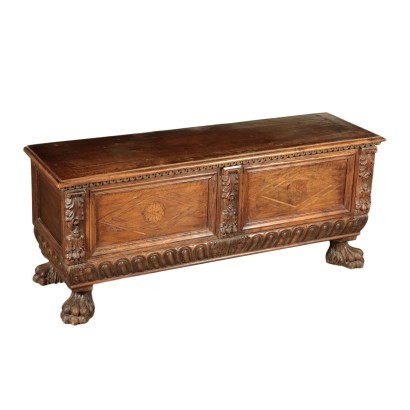Engraved and Inlaid Ottoman Walnut Italy 19th-20th Century
Features
Style: Neo-Renaissance Revival
Age: 19th Century / 1801 - 1900 , 20th Century / 1901 - 2000
Origin: Italy
Main essence: Walnut
Description
Walnut ottoman. Supported by 4 leonine feet; shows a rich podding inlay on the lower band and on the upper one; inlaid with leafy patterns on the pillars and on the central pretend half pilaster. The front side is divided in 2 reserves inside which there are inlays with lozenges and reosewindows patterns.
Product Condition:
Fair condition. Wear consistent with age and use.
Dimensions (cm):
Height: 64
Width: 152,5
Depth: 46
Additional Information
Style: Neo-Renaissance Revival
Stylistic revival, from the 1900s, of the forms typical of the Renaissance style.This is a style that re-proposes, looking at the grandeur of the past, decorative motifs and decorations typical of the 1500s.
Mascheroni, cornices, columns carved with herms that make up typical architectural structures of Renaissance palaces, are the elements that characterize the Neo-Renaissance style.
These elements will remain in the production of furniture until the early 1900s, contaminating themselves with floral elements.
Find out more about the Neo-Renaissance with our insights:
A Milanese library between the Belle Epoque and Fascism



























